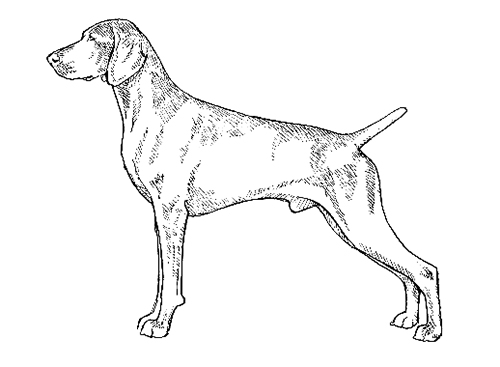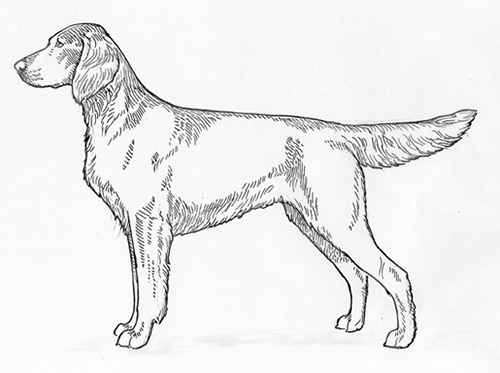Weimaraner
Gun Dog Group
The goals and purposes of this breed standard include: to furnish guidelines for breeders who wish to maintain the quality of their breed and to improve it; to advance this breed to a state of similarity throughout the world; and to act as a guide for judges. Breeders and judges have the responsibility to avoid any conditions or exaggerations that are detrimental to the health, welfare, essence and soundness of this breed, and must take the responsibility to see that these are not perpetuated.
Any departure from the following should be considered a fault, and the seriousness with which the fault should be regarded should be in exact proportion to its degree and its effect upon the health and welfare of the dog and on the dogs ability to perform its traditional work.
History
The Weimaraner originated in the early 19th century in Germany, where it was conscientiously developed and bred to maintain its physical and mental characteristics, and jealously guarded. The ideal dog was one that possessed courage, speed, intelligence and a well-developed scenting ability. The breed was originally used for big game, but was later adapted to use as a bird dog; and was found to be a good pointer and retriever.
The Weimaraner was recognized by the United Kennel Club in 1955.
General Appearance
The Weimaraner is a medium-sized gray dog with fine, aristocratic features. The breed presents an overall picture of grace, speed, stamina, alertness and balance. In proportion, he is just slightly longer than tall. The dog's conformation, structure and musculature must always indicate the ability to work with great speed and endurance.
Working dogs are not to be penalized under any conditions for scars or blemishes that are due to hunting injuries.
Serious Faults: Doggy bitches. Bitchy dogs. Improper muscular condition.
Disqualifications: Unilateral or bilateral cryptorchid.
Characteristics
The breed has a friendly, fearless, alert and obedient temperament.
Disqualifications: Viciousness or extreme shyness.
Head
The moderately long, aristocratic head has a slight median line extending back over the forehead. The stop is moderate.
SKULL
Broader in males than in females, but always in proportion to the overall length of the head. The occiput is rather prominent. The trumpets (temples) are well set back; beginning behind the eye sockets.
MUZZLE
Measured from nose to stop, the muzzle is slightly longer than the skull. It is strong and powerful, especially in the male. The flews are straight; delicate at the nostrils. The skin is drawn tightly. Pigment on the lips and gums is in pinkish flesh shades.
Very Serious Fault: Black-mottled mouth.
Serious Fault: Snipey muzzle.
TEETH
A full complement of well set, strong, even, white teeth meet in a scissors bite.
Serious Faults: Badly affected teeth. More than four missing teeth.
Eliminating Faults: Overshot or undershot bite.
EYES
Acceptable eye colors include shades of light amber, gray or blue-gray. They may appear almost black when dilated under excitement. The eyes are set well enough apart to indicate intelligence and a good disposition. Expression is kind, keen and intelligent.
Very Serious Fault: Any eye color other than those indicated as acceptable.
Eliminating Faults: Entropionism or ectropionism.
NOSE
The nose is gray.
Minor Fault: Pink nose.
EARS
The long, lobular, slightly folded ears are set high. When drawn snugly alongside the jaw, the ear ends approximately 2 inches from the point of the nose.
Serious Fault: Short ears.
Neck
The moderately long neck is clean, arched and carried in a manner that gives the dog a noble appearance.
Serious Faults: Neck too short, thick or throaty.
Forequarters
Shoulder blades and upper arms are long, sloping and well angulated. The withers are well defined.
FORELEGS
The forelegs are straight and strong. The distance from the elbow to the ground is slightly greater than the distance from the top of the withers to the elbow. Dewclaws may be removed.
Serious Faults: Elbows in or out.
Body
The deep chest is well-developed, with the brisket extending to the elbow. Forechest is well developed. In profile, excessive tissue does not protrude from the forechest to the point of exaggeration.
The moderately long topline is straight and strong, sloping slightly from the withers. Ribs are long and well sprung but not barrel shaped. Tuck up is moderate.
Serious Faults: Back too long or too short. Roached or sway back.
Hindquarters
Musculature is well-developed.
HIND LEGS
Long and sinewy with well defined muscles and clearly visible tendons. Well angulated at the stifle. Removal of rear dewclaws is customary but not mandatory.
Serious Fault: Cow hocks.
Feet
The webbed feet are firm and compact. The toes are well arched. The pads are closed and thick. The short nails are gray or amber in color.
Serious Faults: Feet east and west. Poor feet.
Tail
Docked tail: At maturity, the docked tail measures approximately 6 inches. It has a tendency to be light rather than heavy. It is carried in a manner expressing confidence and sound temperament.
Natural tail: Strong and well coated, set-on slightly lower than with other similar breeds. Good plume on long-haired dogs. At rest the tail hangs down. When working or alert the tail is carried level or higher.
Serious Fault: Low set tail.
Coat
Short-Haired
The coat is short, very dense, smooth and sleek. With or without a very sparse undercoat.
Long-Haired
Soft, long topcoat, with or without undercoat. May be smooth or slightly wavy. The hair is long and flowing at the ear set-on. Velvety hair is permissible on the tips of the ears. Coat length on the flanks is approximately 1 to 2 inches; and is generally longer of the lower side of the neck, the forechest, the belly, and the tail. Slight feathering on legs, chest and underside is allowed.
Serious Fault: Mixture of coat varieties.
Color
Solid colors in shades ranging mouse-gray to silver-gray; usually blending to lighter shades on the head and ears. A small white marking on the chest and on the toes are acceptable. As the Weimaraner is a working dog, any white spots denoting scars or as a result of injury are not to be penalized.
Eliminating Faults: Any white other than a spot on the chest and toes. Coat color other than gray. Widespread brown markings. Distinctly blue-colored coat.
Faults: Distinct reddish-yellow marking. Tan or Brown markings.
Disqualifications: Distinctly Black-colored coat. Albinism.
Height
Height range, measured at the withers, for males is from 23 to 27 inches, with the ideal being from 24 to 26 inches.
Height range for females is from 22 to 25 inches, with the ideal being from 23 to 25 inches.
Eliminating Faults: Males measuring less than 23 inches or more than 27 inches. Bitches measuring less than 22 inches or more than 25 inches.
Gait
An effortless gait indicating smooth coordination. When viewed from the rear, the hind feet are parallel to the front feet. When viewed from the side, the topline remains strong and level.
Serious Fault: Poor gait.
Eliminating Faults
(An Eliminating Fault is a Fault serious enough that it eliminates the dog from obtaining any awards in a conformation event.)
Eliminating Faults: Males measuring less than 23 inches or more than 27 inches. Bitches measuring less than 22 inches or more than 25 inches.
Overshot or undershot bite.
Coat color other than gray.
Any white other than a spot on the chest and feet.
Wide spread brown marking.
Distinctly blue-colored coat.
Entropianism or ectropianism.
Disqualifications
(A dog with a Disqualification must not be considered for placement in a conformation event, and must be reported to UKC.)
Unilateral or bilateral cryptorchid.
Viciousness or extreme shyness.
Albinism.
Distinctly black-colored coat.
The docking of tails and cropping of ears in America is legal and remains a personal choice. However, as an international registry, the United Kennel Club is aware that the practices of cropping and docking have been forbidden in some countries. In light of these developments, the United Kennel Club feels that no dog in any UKC event, including conformation, shall be penalized for a full tail or natural ears.

Short haired.

Long haired.
Looking for a Dog?
Find a dog that will fit your family.
Note: The breeders on this list are not endorsed by UKC.
Revised May 1, 2017
©Copyright 1995, United Kennel Club
